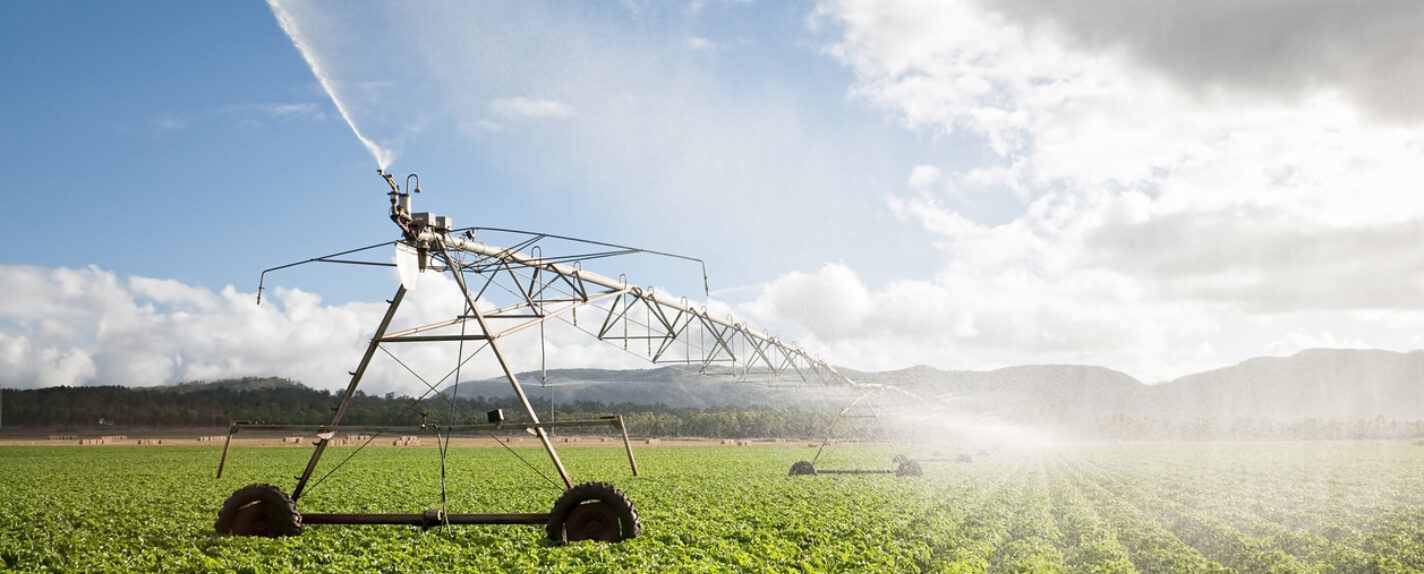Ninth Circuit Clarifies Irrigation Return Flows Permit Exemption

The U.S. Court of Appeals for the Ninth Circuit recently issued an important decision at the intersection of irrigation water law and the Clean Water Act (CWA), with implications for over 53 million acres of irrigated land nationwide. The CWA expressly exempts irrigation return flows—the portions of irrigation water that are not consumed by crops or evaporated and instead flow back to surface waters by some means—from needing coverage under a National Pollution Discharge Elimination System (NPDES) permit. In Pacific Coast Federation of Fishermen’s Associations Inc. v. Nickels, the Ninth Circuit held that when water in an agricultural drainage system contains pollutants from nonpoint sources, the presence of those pollutants in the drain does not abrogate the CWA’s permit exemption for “‘discharges composed entirely of return flows from irrigated agriculture.’” This decision provides the agriculture community much-needed clarity regarding the scope of the return flows exemption.
Prior to Nickels, there was uncertainty over whether the exemption would apply if any return flows in an irrigation drain were unrelated to crop production.[1] Such an interpretation would have effectively eliminated the exemption, as any drainage system would inevitably capture some pollutants from nonpoint sources in the drainage area.[2] In Nickels, the court held that contributions from nonpoint sources to the return flows did not require permits, because to “adopt Plaintiffs’ position would contravene the text, purpose, and structure of the Clean Water Act and render the exemption for irrigated agriculture a dead letter.”[3]
Factual Background
Nickels involved an irrigation drainage system in California’s Central Valley.[4] Irrigation and drainage are inextricably linked because any project that brings fresh water to agricultural ground must drain away the salty water.[5] This drainage system was designed to recover and collect irrigation runoff from nearly 100,000 acres of agricultural land and convey the drainage though a concrete-lined system to discharge into a wetland.[6] The drain also collects groundwater that seeps into the drain.[7] The wetland where the drainage water is discharged is a water of the United States regulated under the CWA.[8] The parties did not dispute that the drainage system is a point source that discharges “pollutants” to a water of the United States.[9] The drainage project is jointly administered by the U.S. Bureau of Reclamation, the San Luis & Delta-Mendota Water Authority, and the Grassland Water District (collectively the Defendants), who jointly operate the drainage system and discharge the drain water into the wetland without a NPDES permit under an exemption from the permitting system for “discharges composed entirely of return flows from irrigated agriculture.”[10] The drainage system captured runoff not just from active agricultural operations, but also from “fallow and retired farmland, as well as non-irrigable land used for public infrastructure, residences, and businesses.”[11] The drainage system also captured runoff from the washing of an array of solar panels on formerly irrigated farmland.[12] However, none of the challenged pollutants originated from point sources unrelated to crop production. The question before the court was whether the sources of pollutants in runoff from activities not associated with crop production eliminated Defendants’ ability to rely on the return flows exemption.[13]
Procedural History: Pacific Coast Federation of Fishermen’s Associations Inc. v. Glaser
For fourteen years, the case has moved through the U.S. District Court for the Eastern District of California and the Ninth Circuit[14] to establish the scope of the term “irrigated agriculture” and the phrase “composed entirely of return flows from irrigated agriculture.”[15] In 2011, Plaintiffs filed suit alleging that Defendants violated the CWA by discharging pollutants that were unrelated to irrigated agriculture without a permit.[16] On cross-motions for summary judgment, the district court found that Plaintiffs failed to meet their burden of showing that return flows were not entirely from irrigated agriculture.[17] The district court further found that “irrigated agriculture” must be interpreted broadly, but the word “entirely” in the exemption must be read to mean that the “majority” of return flows must be from irrigated agriculture.[18] Otherwise, the statute would be meaningless. The Ninth Circuit in Pacific Coast Federation of Fishermen’s Associations Inc. v. Glaser reversed and remanded, holding that while the district court correctly interpreted the broad meaning of “irrigated agriculture,” the district court erred in 1) placing the burden on Plaintiffs rather than on Defendants to demonstrate their entitlement to the exemption, and 2) finding the word “entirely” to mean “majority.” The Ninth Circuit held that Congress’ use of the word “entirely” means “discharges that include return flows from activities unrelated to crop production [are] excluded from the statutory exception, thus requiring an NPDES permit for such discharges.”[19]
The court’s holding in Glaser, that any return flows containing pollutants from activities unrelated to crop production required a permit, caused considerable confusion among operators of irrigation drains. The court’s holding, on its face, suggested that the exemption was exceedingly narrow, if it remained intact at all after Glaser.
District Court Decision on Remand
On remand, however, the district court distinguished between “discharges” from point sources subject to NPDES permits and pollutants entering the drain from nonpoint sources that were not subject to NPDES permits.[20] The district court found that Defendants met their burden of establishing their entitlement to the exemption because “plaintiffs’ alleged sources of pollutants . . . are not added from an extra or supplementary point source that is unrelated to the Project’s overall drainage function.”[21] Defendants further carried their burden to establish that the allegedly disqualifying pollutants were either “added from a nonpoint source or [were] added from a point source that related to the Project’s overall drainage function.”[22] The district court limited the term “entirely” to the universe of pollutants discharged from point sources.
Ninth Circuit’s Opinion in Nickels
The Ninth Circuit affirmed the district court’s partial grant of summary judgement and its conclusion that Defendants met their burden of establishing entitlement to the irrigation return flows exemption.[23]
Appellants challenged the Project’s exempt status, arguing that, because the return flows contain pollutants that did not originate from irrigated agriculture, the discharge was not “composed entirely” or “solely” of discharges from irrigated agriculture.[24] Under this theory, any irrigation return flows that commingled with any other pollutants from any other source would require an NPDES permit.[25] Appellants argued that the CWA regulates pollutants discharged from a point source, and that Congress’s use of “entirely” in the exemption, required the court to hold that the exemption only applied if the return flows contained pollutants only from return flows.[26]
The court relied on its prior opinion that established that “irrigated agriculture” includes “all activities related to crop production”[27] and that “entirely” follows its ordinary meaning of “wholly, completely, fully.”[28] But the court then found that the term “entirely” is ambiguous as to what “category of objects” the term is meant to exclude.[29] The court examined the question of whether the pollutants had to come entirely from irrigated agriculture or only the “discharges.”[30]
Because “entirely” in this context was ambiguous, the court turned to a “highly probative” section of the legislative history to determine Congress’ intent in passing the exemption.[31] The legislators who authored the exemption also drafted a report which used key statutory terms as they are defined in the statute.[32] The report explains that “‘the word “entirely” was intended to limit the exception to only those flows which do not contain additional discharges from activities unrelated to crop production.’”[33] The terms “discharge” and “discharge of a pollutant” are statutorily defined terms which are limited to the addition of any pollutant to navigable waters from any point source.[34] Relying on these statutory definitions the court held that the exemption applies to irrigation return flows that do not contain additional point source discharges because that reading is consistent with the overall structure of the CWA, which does not regulate nonpoint sources of pollution.[35]
The court also found that this interpretation is consistent with Congress’s intent in including the return flows exemption in the 1977 amendments to the CWA.[36] Congress passed the irrigation return flows exemption for three primary reasons: (1) to reduce EPA’s burden to issue an excessive number of permits related to irrigated agriculture, (2) to address the unequal treatment between farmers who depend on rainfall to irrigate their crops who were not subject to NPDES permitting and farmers who rely on surface irrigation if they were required to obtain a permit for return flows, and (3) to address the technical difficulties of regulating return flow pollutants through the NPDES permitting program because it was “practically impossible to determine whether agricultural pollutants were originally from point or nonpoint sources.”[37] Congress determined that irrigation return flows were best managed under Section 208 of the CWA through direct regulation by the States along with nonpoint sources of pollution rather than requiring EPA to undergo the impossible task of separating the point source and nonpoint source pollutants in each and every return flow across the United States.[38] Under the court’s interpretation, the operator of the drain only needs to show that there are no additional point sources, without quantifying the amount of pollutants in the commingled wastewater from each individual source.[39]
If Appellants’ interpretation were adopted, the court reasoned, then none of Congress’s primary goals would be achieved, and the exemption would effectively be read out of the CWA because it would be impossible to ensure that no nonpoint source pollution, like windblown dust, ever enters the return flows conveyance.[40]
Implications of Nickels
The Ninth Circuit covers much of the territory where irrigated agriculture takes place in the United States. In Nickels, the court made it clear that the irrigation return flows exemption is not defeated when “diffuse ‘nonpoint source’ pollution—such as pollution from rainwater runoff or windblown dust and algae—commingles with the Project’s return flows prior to discharge into waters of the United States.”[41]
For more information on the impacts of Nickels or to discuss how this decision impacts your system, please contact Albert Barker, Brian Daluiso, or Bryce Brown.
[1] Pacific Coast Fed’n of Fishermen’s Ass’ns v. Glaser, 945 F.3d 1076, 1085 (9th Cir. 2019).
[2] See Nickels, 2025 WL 2553725 at *8-*9.
[3] Id. at *2.
[4] Id. at *4.
[5] Id. (citing Firebaugh Canal Co. v. United States, 203 F.3d 568, 571 (9th Cir. 2000)).
[6] Id. at *4-*5.
[7] Id. at *5.
[8] See id.
[9] Id.
[10] Id. at *4, *6.
[11] Id. at *4.
[12] Id.
[13] Id. at *2.
[14] In 2019, the Ninth Circuit reversed and remanded several issues from a prior partial denial and partial grant of cross-motions for summary judgement. See Pacific Coast Fed’n of Fishermen’s Ass’ns v. Glaser, 945 F.3d 1076 (9th Cir. 2019).
[15] Id. at 1083
[16] Id. at 1081.
[17] Id. at 1082.
[18] Id. at 1082-83.
[19] Id. at 1085.
[20] Pacific Coast Fed’n of Fishermen’s Ass’ns v. Conant, 657 F.Supp.3d 1341, 1359-60 (E.D. Cal. 2023).
[21] Id. at *1360.
[22] Nickels, 2025 WL 2553725 at *6; Conant, 657 F.Supp.3d at1362-63.
[23] Nickels, 2025 WL 2553725 at *6
[24] Id.
[25] Id.
[26] Id.
[27] In Glaser, the Ninth Circuit noted that activities related to crop production included fallowed and retired fields, but did not provide a detailed explanation of what that phrase means. Pacific Coast Federation of Fisherman’s Ass’ns v. Glaser, 945 F.3d. 1076, 1084-85 (9th Cir. 2019).
[28] Nickels, 2025 WL 2553725 at *7.
[29] Id.
[30] Id.
[31] Id.
[32] Id.
[33] Id. (citing S. Rep. No. 950379, 35).
[34] 33 U.S.C. §§ 1362(12), 1362(16).
[35] Id. at *8.
[36] Id.
[37] Id. (citing S. Rep. No. 95-370, 35).
[38] Id. (citing S. Rep. No. 95-370, 35).
[39] Id. at *8-*9.
[40] Id.
[41] Id.
Authors
Related Services and Industries
Authors
Related Services and Industries
Stay Informed
Sign up for our law and policy newsletter to receive email alerts and in-depth articles on recent developments and cutting-edge debates within our core practice areas.


